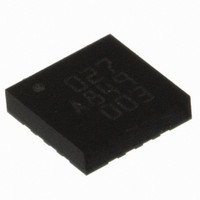BMA145 Bosch Sensortec, BMA145 Datasheet - Page 3

BMA145
Manufacturer Part Number
BMA145
Description
3-AXIS ACCELEROMETER ANALOG I/F
Manufacturer
Bosch Sensortec
Specifications of BMA145
Axis
X, Y, Z
Acceleration Range
±4g
Sensitivity
300mV/g
Voltage - Supply
1.8 V ~ 3.5 V
Output Type
Analog
Bandwidth
1.5kHz
Interface
Parallel
Mounting Type
Surface Mount
Package / Case
16-LGA
For Use With
828-1011 - BMA145 DAUGHTERCARD FOR DEV KIT
Lead Free Status / RoHS Status
Lead free / RoHS Compliant
Other names
828-1002-2
BMA145
Data sheet
Bosch Sensortec
Triaxial, analog acceleration sensor
T
BMA145
HE
IN GENERAL
The BMA145 is a triaxial low-g acceleration sensor for consumer market applications, available
in a standard SMD LGA package with a footprint of 4mm x 4mm and a height of only 0.9mm. It
allows measurements of static as well as dynamic accelerations. Due to its three perpendicular
axes it gives the absolute orientation in a gravity field and enables free-fall detection. As all
other Bosch inertial sensors, the BMA145 is a two-chip arrangement, which combines an
application-specific integrated circuit (ASIC) with a three-channel silicon accelerometer, to form
a true micro electro mechanical system (MEMS).
The ASIC evaluates the output of the acceleration-sensing element, corresponding to the
differential capacitance principle. The underlying MEMS technology processes have proven
their capability according to the strictest automotive standards in more than 100 million Bosch
inertial sensors a year so far.
The BMA145 provides 3 parallel analog output signals in a ±4g acceleration range. All
acceleration signals are permanently available on 3 independent analog pads through 33kΩ
resistors on each pad. This allows the user defining the signal bandwidth by the mean of
external capacitors connected between each channel output and ground. Additional to the
parallel X, Y and Z output signals there is the option to multiplex any axis to 1 supplementary
output pin in a freely customized manner. This allows the user to connect the triaxial BMA145 to
an economical single channel AD converter without loss of axis information.
st
For each axis, an independent analog 1.5 kHz 1
-order low-pass filter is included to provide
preconditioning of the measured acceleration signal. The corner frequency of this filter can
easily be customized. Additional signal preconditioning steps are performed by a digital to
analog converter for offset and gain correction purposes with a subsequent signal amplification.
The output signals are ratiometric. In the ±4g acceleration range the sensor is offering a
sensitivity of 300mV/g at 3.0 V supply voltage (V
/ 10) and 220µg/√Hz as a typical noise level.
DD
The typical current consumption is 200µA in operation mode. Furthermore, the sensor can be
switched into a standby mode via supplementary selection pins. In standby mode the sensor
module features an ultra low current consumption of typically 0.7 µA. The return from standby
mode to full performance conditions is performed in less than 1ms wake up time.
The BMA145 sensor module is ready to use due to test and calibration at factory level. All
calibration parameters, e.g. for offset and sensitivity, are stored in an internal EEPROM. The
sensor also features full self-test capability for all three axes. It is activated via a single self test
activation pin which results in a physical deflection of the seismic mass in the sensing element
due to electrostatic forces. Thus, it provides full contact and functional testing of the complete
signal evaluation path including the MEMS acceleration-sensing element and the evaluation
ASIC.
Rev. 1.1
Page 3
02 April 2008
© Bosch Sensortec GmbH reserves all rights even in the event of industrial property rights. We reserve all rights of disposal such
as copying and passing on to third parties. BOSCH and the symbol are registered trademarks of Robert Bosch GmbH, Germany.
Note: Specifications within this document are subject to change without notice.

























